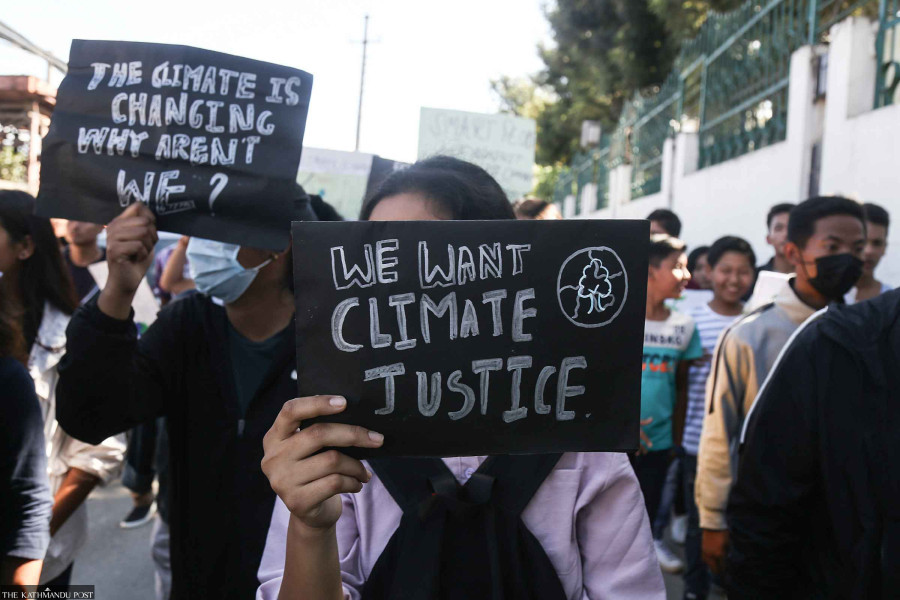Columns
Catalysing Nepal’s climate commitment
Discerning whether climate change is a priority for the parties or a political tool is challenging.
Subash Pandey
Nepal submitted its first Nationally Determined Contribution (NDC) in 2016 and its second in December 2020 to achieve net-zero status by 2045. The country’s pursuit of a sustainable, low-carbon future through its NDCs has been marked by ambition but hampered by numerous challenges. While its dedication to climate action is evident, the focus must now shift from policy creation to effective implementation to achieve tangible results in line with the Paris Agreement goals.
Multiple factors are crucial in determining the implementation of the NDCs. Some key factors are climate finance, clearly defined roles and responsibilities (by whom, how and stakeholder engagement), political acceptance and stability, institutional memory, and alignment between federal and local governments.
Implementation of the second NDC is estimated to cost $78.4 billion, nearly double Nepal’s GDP. The availability of climate finance will be pivotal in determining whether countries like Nepal will achieve their NDC goals.
Political acceptance
Differences exist among political parties regarding political economy. However, when it comes to climate change, all of them appear connected, concerned and share one voice to act. This unity is evident from the fact that many climate policies in Nepal, including the second NDCs, were endorsed by the cabinet with a majority. Such endorsement would not have been possible without the acceptance of the political parties. Further evidence of political acceptance of the NDCs lies in the fact that major political parties mention climate change and net-zero commitments in their latest election manifestos.
However, when examining their actions, such as the erratic tax policy on electric vehicles and plans to construct an airport in a densely forested area without rigorous scientific analysis, it becomes evident that they are using climate change only as a political platform. Moreover, politicians expect Nepal to get climate finance from the international community, implying a belief that the country need not allocate its internal resources for climate action. Thus, discerning whether climate change is a genuine priority for political parties or merely a political tool to secure votes during elections remains challenging. While climate change is gradually becoming part of the political agenda, bridging the gap between the political parties' climate commitments and their actions remains a challenge.
In addition to lack of political priority, political instability has affected the implementation of the NDCs in Nepal. Frequent changes in government and shifting priorities within political parties led to delays in coming up with NDC implementation plans. This is evident from the fact that the NDC implementation plan had been stuck in the Cabinet for over three years, and only recently received approval. As it is now mid-2023, Nepal has limited time to make progress and update its NDC by 2025.
Since the submission of the first NDC in 2016, Nepal has witnessed the appointment of eight ministers at the Ministry of Forest and Environment, and experienced three chiefs in the Climate Change Management Division (CCMD), which was established in 2019 to coordinate climate-related activities. High staff turnover has resulted in low institutional memory, negatively impacting progress in climate activities, especially in monitoring, reporting and verifying NDC achievements.
Moreover, there is a norm that the CCMD chief holds its position for only one-two years. Individuals leading the CCMD have backgrounds in forestry and wildlife, making it challenging for them to rapidly comprehend United Nations Framework Convention on Climate Change (UNFCCC) processes, acronyms and jargon used in climate change within a short time. Therefore, unless Nepal achieves political and institutional stability, developing robust institutions capable of translating climate commitments into actions remains unlikely. Without the Ministry of Forest and Environment becoming a priority for the political parties, Nepal will continue to approach climate change on an ad-hoc basis rather than addressing it systematically.
Despite the adoption of a new federal structure in Nepal with more power given to local and provincial governments, climate policies, especially NDCs, are driven by the federal government.
The problem is that Nepal’s NDC is too centralised. The NDC does not touch the local government, not even the provincial government. If we look at the NDC, it only communicates with the federal sectoral ministries. This is because all our climate policies are driven by the international climate framework. We negotiate at the international level and later translate them into national policies. The whole international discourse on international climate change is only about the recognition of national-level climate actions.
Furthermore, Nepal's governance structure, particularly in environmental sectors, adopts a top-down approach, resulting in inadequate policy implementation. The policy governance structure is designed in a way that always gives power to the central government. While Nepal has established Provincial Climate Change Coordination Committees, they remain inactive. Nepal often expresses the need for funding from international actors for climate actions, but these funds are centralised. The climate agenda has yet to fully permeate beyond Singha Durbar in Nepal. Unless provincial and local governments possess necessary financial and technical resources, they may struggle to take independent action.
Recommendation for Nepal
To ensure the retention of strong institutional memory that facilitates climate actions, Nepal should establish a mechanism to send the same key negotiators and government officials to the Conference of Parties for a longer time. This will enhance understanding of the UNFCCC working mechanism and bolster Nepal's climate goal credibility. Additionally, officials from the CCMD should serve longer tenures, ideally five years, to oversee a complete cycle of NDC formulation and implementation.
The new constitution of Nepal has given authority and autonomy to the provinces and the local governments to generate their own revenues and climate adaptation and mitigation policies. However, in practice, this undergoing political transition has resulted in a struggle over authority and material resources. The provincial and local governments should leverage their authority to prioritise their own climate actions. Furthermore, the federal government should immediately inform the provincial and local governments about the climate goals it has proposed. The federal government should develop short, clear policy briefs of each policy initiative in accessible language for distribution to all local governments to increase their climate knowledge.




 12.12°C Kathmandu
12.12°C Kathmandu













%20(1).jpg&w=300&height=200)

